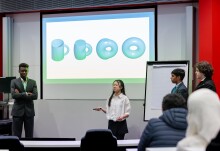

Discovery could explain evidence behind Mums' mantra 'eat your greens'
Research led by Dr Paul Evans, and funded by the BHF may have revealed why vegetables are good for the heart. The findings suggest that a chemical found in vegetables such as broccoli, cabbage and cauliflower, can boost a natural defence mechanism to protect arteries from disease.
Arteries don't clog up in a uniform way. Bends and branches of blood vessels - where blood flow is disrupted and can be sluggish - are much more prone to the build-up of fatty plaques known as atherosclerosis. Atherosclerosis can lead to angina, heart attack and stroke.
BHF-funded researchers from Imperial College London have discovered that a normally-protective protein called Nrf2 is inactive in areas of arteries that are susceptible to disease. But, they also found that treatment with a chemical found in certain vegetables - known to gardeners as ‘brassicas' - can activate Nrf2 in these disease-prone regions.
Dr Paul Evans from the National Heart and Lung Institute at Imperial College London, who led the research team, said: "We found that the innermost layer of cells at branches and bends of arteries lack the active form of Nrf2, which may explain why they are prone to inflammation and disease. Treatment with the natural compound sulforaphane reduced inflammation at the high-risk areas by 'switching on' Nrf2.
"Sulforaphane is found naturally in broccoli, so our next steps include testing whether simply eating broccoli, or other vegetables in their ‘family', has the same protective effect. We also need to see if the compound can reduce the progression of disease in affected arteries."
Brassicas - also called ‘cruciferous' vegetables - include broccoli (which has the highest levels of sulforaphane), cabbage, kale, Brussels sprouts, cauliflower, bok choy and rocket. Using normal mice, and mice engineered to lack the Nrf2 protein, the research found that in straight sections of arteries Nrf2 was present in the endothelial ‘lining' cells. Through its action on other proteins, it prevented the cells from becoming inflamed, which is an early stage in the development of atherosclerosis.
In the lining cells of disease-prone sites - such as bending or branched arteries - Nrf2 was attached to a protein that made it inactive. This stifled its protective properties.
The addition of sulforaphane re-activated Nrf2 in the disease-prone regions of the artery, restoring the cells' ability to protect themselves from becoming inflamed. The researchers believe that this will enable these artery regions to remain healthy for longer, or even reduce the progression of existing disease. This will be tested in their next phase of research.
This research was carried out in the BHF Cardiovascular Medicine Unit at the National Heart and Lung Institute. The Unit is headed by BHF Chair, Professor Dorian Haskard, and is part of the BHF Centre of Research Excellence at Imperial College London.
The research was published this month in the journal Arteriosclerosis Thrombosis and Vascular Biology
Research reference: Activation of Nrf2 in Endothelial Cells Protects Arteries From Exhibiting a Proinflammatory State. M Zakkar et al. Arteriosclerosis Thrombosis and Vascular Biology DOI: 10.1161/ATVBAHA.109.193375
For more information please contact:
The BHF press office on 020 7554 0164 or 07764 290 381 (out of office hours) or email newsdesk@bhf.org.uk
The Imperial College London Press Office on 020 7594 6702 or 07803 886 248 (out of office hours) or email lucy.goodchild@imperial.ac.uk
Article text (excluding photos or graphics) available under an Attribution-NonCommercial-ShareAlike Creative Commons license.
Photos and graphics subject to third party copyright used with permission or © Imperial College London.





